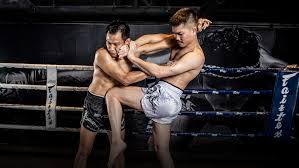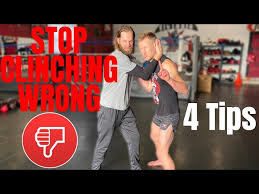Muay Thai, also known as the “Art of Eight Limbs,” is a traditional Thai martial art renowned for its powerful strikes, diverse techniques, and intricate clinch work. Among the many facets of Muay Thai, the clinch is a critical component that can turn the tide of a fight by controlling an opponent’s movements and setting up devastating strikes or takedowns. For beginners, mastering the clinch can be challenging but highly rewarding. This article will delve into the essential Muay Thai clinch techniques and strategies for beginners, helping you develop a solid foundation in this fundamental aspect of the sport.
1. Understanding the Clinch in Muay Thai

The clinch, or “Phae” in Thai, is a close-quarters grappling technique used to control an opponent’s posture and movement. It involves engaging your opponent in a standing position to limit their striking options and create opportunities for your own attacks. The clinch is essential for Muay Thai fighters, as it allows them to exploit openings and capitalize on their opponent’s weaknesses.
Key Benefits of Mastering the Clinch:
- Control: The clinch allows you to dictate the pace and direction of the fight by controlling your opponent’s movements.
- Striking Opportunities: From the clinch, you can deliver powerful knees, elbows, and other strikes.
- Takedowns: The clinch provides the opportunity to execute throws and takedowns, potentially ending the fight or gaining positional advantage.
2. Basic Clinch Techniques for Beginners
2.1 The Basic Clinch Position
Before diving into specific techniques, it’s crucial to understand the basic clinch position:
- Hand Placement: Place your hands on the back of your opponent’s head or behind their neck. This position provides control and leverage.
- Elbow Positioning: Keep your elbows close to your body to maintain balance and prevent your opponent from breaking free.
- Body Position: Maintain a low stance with your hips slightly forward. This position helps you stay balanced and makes it harder for your opponent to push you off.
2.2 The Muay Thai Clinch Grip
The Muay Thai clinch grip is a fundamental technique that involves controlling your opponent’s head and neck:
- Collar Tie: Use your dominant hand to grab the back of your opponent’s neck while the other hand supports or grips their collar. This grip allows you to pull your opponent’s head down and control their posture.
- Overhook and Underhook: Position one arm over your opponent’s arm and the other arm under their arm to gain control. This grip is effective for breaking your opponent’s posture and setting up strikes.
2.3 Knee Strikes from the Clinch
Knee strikes are a powerful weapon when executed from the clinch:
- Basic Knee Strike: From the clinch, lift your knee up towards your opponent’s midsection or head. Aim to drive your knee forward with force, using your hip and core muscles.
- Diagonal Knee Strike: Use your opposite knee to target your opponent’s body at an angle. This technique can be effective for landing strikes to the ribs or torso.
2.4 Elbow Strikes from the Clinch
Elbow strikes can be devastating when delivered from the clinch:
- Vertical Elbow: Bring your elbow straight downwards towards your opponent’s head or body. This technique is effective for striking while staying close in the clinch.
- Horizontal Elbow: Rotate your body and extend your elbow horizontally to target your opponent’s face or body. This strike can be powerful when executed with proper technique.
2.5 The Sweep
Sweeps are techniques used to off-balance your opponent and potentially bring them to the ground:
- Basic Sweep: While in the clinch, use your leg to hook your opponent’s leg or ankle. Push or pull with your upper body to off-balance them and execute the sweep.
- Inside Sweep: Position your leg on the inside of your opponent’s leg and use your upper body to push or pull them off balance.
3. Training Tips for Effective Clinch Work
3.1 Drilling with a Partner
Regular practice with a partner is essential for mastering clinch techniques. Drilling allows you to:
- Improve Technique: Repeated practice helps refine your clinch technique and timing.
- Increase Comfort: Practicing with a partner helps you become more comfortable in close-quarters situations.
- Develop Timing: Working with a partner helps improve your ability to time your clinch entries and exits.
3.2 Shadowboxing
Incorporate clinch techniques into your shadowboxing routine to:
- Visualize Techniques: Practice the movements and transitions of clinch work without a partner.
- Improve Fluidity: Shadowboxing helps develop smooth transitions between clinch techniques and other strikes.
3.3 Strength and Conditioning
Strength and conditioning exercises are crucial for enhancing clinch performance:
- Core Strength: Strengthening your core helps with stability and balance during clinch work.
- Grip Strength: Exercises to improve grip strength help with maintaining control in the clinch.
- Leg Strength: Strong legs are essential for executing sweeps and maintaining balance in the clinch.
3.4 Flexibility Training
Flexibility plays a significant role in clinch work:
- Hip Flexibility: Improved hip flexibility enhances your ability to execute knee strikes and maintain balance.
- Shoulder Flexibility: Flexible shoulders help with various clinch grips and strikes.
4. Common Mistakes to Avoid in the Clinch

4.1 Overcommitting
Avoid overcommitting to a single technique or position. Overcommitting can leave you vulnerable to counters and disrupt your balance. Maintain a balanced approach and be ready to adapt.
4.2 Poor Posture
Maintaining proper posture is crucial for effective clinch work. Avoid slouching or leaning too far forward, as this can affect your balance and control.
4.3 Neglecting Defense
While focusing on offensive techniques, don’t neglect defensive aspects of the clinch. Be aware of your opponent’s movements and be prepared to defend against their attacks.
5. Conclusion
The clinch is a vital aspect of Muay Thai that can greatly impact your performance in the ring. For beginners, mastering the basic clinch techniques such as grips, knee strikes, elbow strikes, and sweeps is essential for building a strong foundation. Regular practice, drilling with partners, and incorporating strength and flexibility training will help you become more proficient in the clinch. By avoiding common mistakes and focusing on proper technique, you can develop the skills needed to control your opponents and gain an edge in your Muay Thai fights. Embrace the learning process, stay dedicated, and you’ll be well on your way to mastering the clinch and excelling in the sport of Muay Thai.



